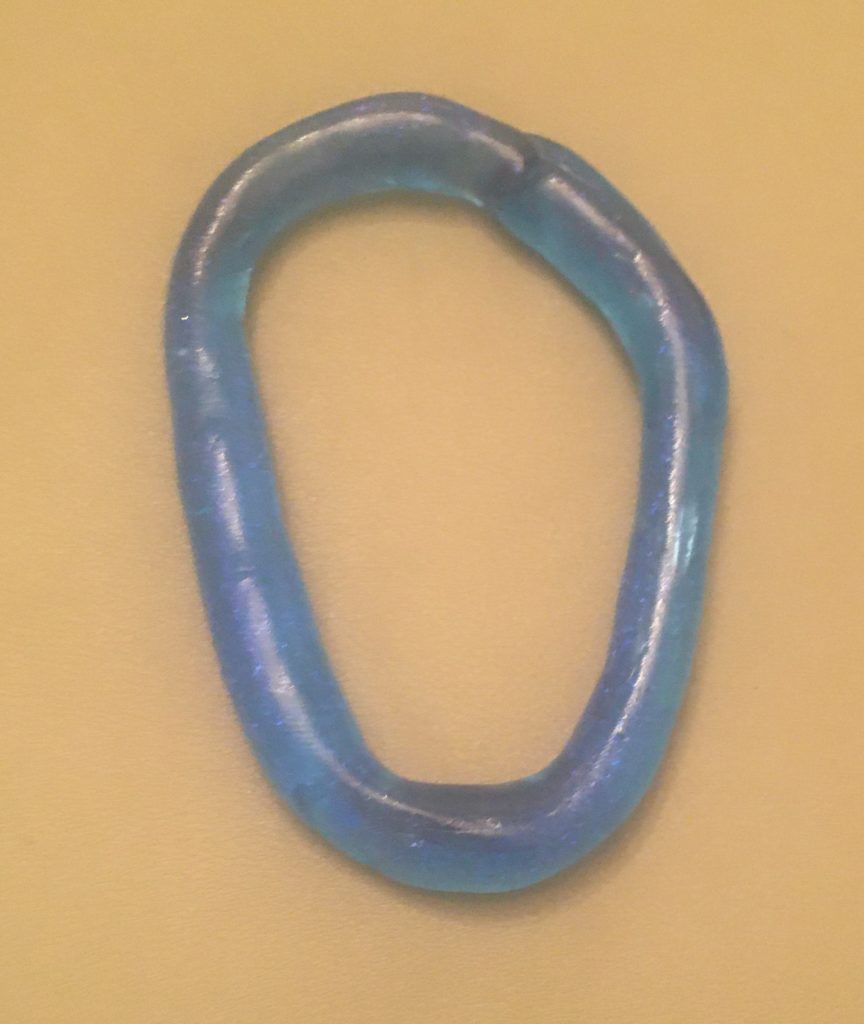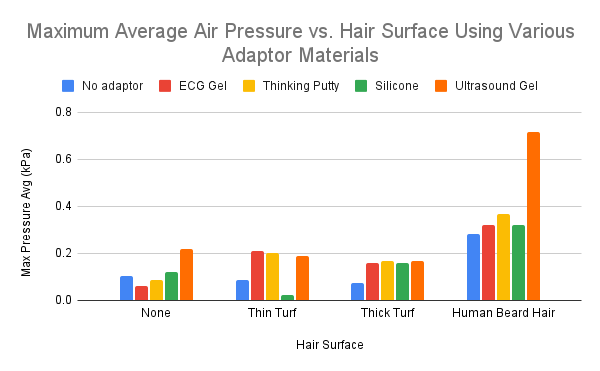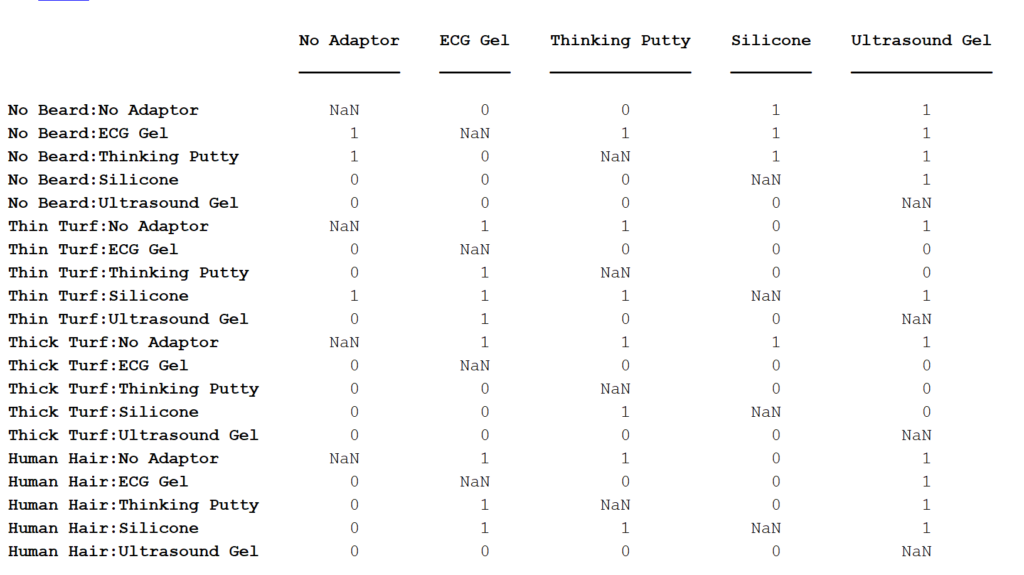
Problem Statement
This project aims to design a portable adaptor device able to attach to an existing ventilation/anesthesia mask to create a tight seal between a bearded patient’s facial hair and the mask. The objective is to improve gaseous medication delivery and minimize leakage. Ideally, this device would conform to any face shape and beard thickness and could be removed from the bearded surface without leaving residue.
Impact
The Problem
- Beard hair longer than an 1/8 inch causes gas leakage during anesthesia administration (Floyd, 2018)
- 246-times more leakage occurs on bearded faces compared to clean shaven (Skredtvedt, 1984)
- Studies found an average of 20-1000% increase in gas leakage in the presence of facial hair (Stobbe, 1988)
The Solution
- Improve quality and equity of care
- Avoid shaving the patient’s beard
- Religious beliefs
- Lifestyle & comfort
- Time consuming & unrealistic in emergency situation
- Improve working conditions for medical professionals
- Reduce fatigue due to difficult masking techniques
Customer Needs/Specifications
The anesthesia mask adaptor must:
- Create a tight seal against facial hair for sufficient gas delivery
- Attach to an existing ventilation/anesthesia mask
- Made from biocompatible material for skin contact
- Peel off completely from face without leaving residue on the face
- Be quickly applied to the patient’s face
Prototypes
Silicone




Crazy Aaron’s Thinking Putty




ECG Gel




Alginate Gel




Ultrasound Gel



Testing
Testing Procedure
Testing Results
Effect of adaptor on maximum air pressure
In order to analyze the adaptor’s ability to create a tight seal against facial hair and prevent gas leakage, testing was conducted to determine the maximum air pressure that can be administered through the mask and adaptor using each prototype.
Force sensitive resistors were applied to the left and right cheeks of manikins with varying degrees of facial hair. These were used to measure the force being applied to the face and adaptor using the EC grip technique. This force was kept as constant as possible within each testing set to minimize variation due to applied force in the masking technique. Air flow was delivered into the mask/adaptor using a ventilation machine set to 22 breaths/min. The air pressure generated inside the mask/adaptor was measured using a sensitive pressure gauge. The maximum recorded air pressure delivered for each breath was recorded and compared across the prototypes.
Ultrasound gel was included in this testing procedure as a positive control. Prior literature indicated success in generating a tight seal against facial hair using this gel (Althunayyan, 2020). However, our customer has indicated that it would not be a suitable material for his purposes due to the significant residue that remains on the patient’s face following its application.

Testing Setup 
Air Pressure Data Collection
Maximum Pressure Test Results
STATISTICAL ANALYSIS of Maximum Pressure test
Concluding Comparisons
| Beard Surface | Material with Highest Pressure | Material with Lowest Pressure |
| No Beard | Silicone | ECG Gel |
| Thin Turf | ECG Gel | Silicone |
| Thick Turf | Thinking Putty | ECG Gel |
| Human Beard Hair | Thinking Putty | Silicone |
Conclusions:
The Thinking Putty adaptor allowed for the highest maximum pressure to be achieved on the most realistic (human beard hair) and most difficult for masking (thick turf) beard surfaces we tested. Therefore, it can be concluded that Thinking Putty is the best material for our adaptor to achieve higher air pressures against bearded surfaces.
Residue
It is important to our customer that no residue is left on the patient’s face after the adaptor is removed from the facial hair following its use. This allows for a seamless workflow to subsequent steps in anesthesia delivery. Tape must be able to be secured to the patient’s face, so residue must not interfere with that process.
In order to analyze residue remaining on the patient’s face following use and removal of the adaptor, the mass of each prototype was measured prior to application to a bearded manikin. After applying proper EC grip technique using the adaptor, the adaptor was removed and the mass was measured again. The change in mass for each prototype was determined.
residue comparison
| Adaptor Material | Percent Decrease in mass | Removal Observations | Residue Observations |
| ECG Gel | 0.22% | Peeled off face in one piece. | No apparent residue. Slightly tacky to the touch. |
| Crazy Aaron’s Thinking Putty | 1.93% | Majority of material peeled off face in one piece. | Small bits of putty remained in turf beards. |
| Silicone | 0.17% | Peeled off face completely in one piece. | Thin tacky film remained on contact area. |
| Ultrasound Gel | N/A | Majority of gel remained on face. | Most gel remained on face. Would require wipe to remove excess gel. |
Conclusions:
All of our adaptor materials (other than ultrasound gel, which was used as a comparison material) resulted in relatively little residue remaining on the face. The silicone adaptor had the smallest decrease in mass after removal, meaning very little mass was left on the face. However, the ECG gel adaptor left the least noticeable residue to the touch, suggesting it would be the most favorable material to minimize residue left on the patient’s face.
Customer Feedback
Our customer, Dr. Breneman, emphasized the importance of the adaptor material not leaving residue on the face, making this a priority in material selection. He inspired us to begin our material investigation and selection with ECG gel and materials with similar properties. Our residue testing results at this point are consistent with his idea.
Dr. Breneman encouraged testing the adaptors for their ability to withstand high gas pressures to indicate a tight seal had been achieved. Due to difficulties in applying constant force across the surfaces using the EC grip, Dr. Breneman suggested that during future testing, with additional equipment, the pressure inside the mask balloon would be incrementally increased, then compared to the maximum pressures inside the mask/adaptor when leakage occurred.
Next Steps
While we have made significant progress, there are opportunities to further build upon our work. Here are our recommendations for future material development, testing and production considerations:
- ECG Gel:
- ECG gel possesses many promising qualities to indicate its favorable use in this device, but a method for generating one smooth surface would need to be utilized to ensure structural stability in this adaptor. The current prototype was constructed by combining many gel patches, but are unable to retain its integrity over time.
- Currently, CONMED ECG gel formulations and properties are proprietary information, and our CONMED contacts were unable to provide additional information.
- Partnering with CONMED may provide an opportunity to more efficiently utilize ECG gel for the production of the adaptor.
- Investigations into additional hydrogels:
- We approximated the gels using an alginate solution, but other patents/formulas are available to replicate.
- Sterilization and Packaging:
- The alginate prototype unfortunately grew mold after ~72 hours in a sealed container. Making these in a sterile environment, and keeping them sterile for their lifetime, is a challenge of its own.
- Ethanol sterilization has been the most promising way to sterilize alginate hydrogels.
- Because of the variety of materials we experimented with, there is no one solution for sterilization & packaging, and must be adapted for each individual material.
- UV light should not induce any major mechanical or chemical changes for silicone.
- Analysis of Mechanical Properties:
- Our analysis was based on the hardness of a material, which is a material’s resistance to penetration. Since low hardness materials are more penetrable, our thinking was that a material with low enough hardness could get the beard hairs to embed themselves in the adaptor instead of being compressed.
- The viscosity, stiffness, and potentially, hardness of the material would need to be tested to ensure that the product is reproducible.
- Improved pressure applied readings:
- We approximated the pressure applied to the mask and adaptor during ventilation based on 2 force sensitive resistors placed on the cheeks. Placing additional FSRs or using long strips (Force Sensitive Resistor Strip) can yield more accurate readings with less error.
Our Team

Meredith Ackley 
Theo Couderc 
Spencer Fink 
Joseph Madejski
Customer
Dr. Stephen Breneman
Anesthesiologist, URMC
Supervisor
Dr. Edmund Lalor
Department of Biomedical Engineering, University of Rochester
Project Liason
Emma Vogan
CMTI, University of Rochester
Acknowledgements
We would like to thank the following people for their advice, assistance and guidance on this project:
- Dr. Stephen Breneman
- Dr. Edmund Lalor
- Emma Vogan
- Dr. Amy Lerner
- Dr. Scott Seidman
- Art Salo
- Dr. Kanika Vats
- Dr. Greg Gdowski
- Cathy VanHouten, MS, RN, CNS, CWON
- Austin Orsini from CONMED Corp.
- Julia Myers
References
Althunayyan, Saqer M. et al. “Using gel for difficult mask ventilation on the bearded patients: a simulation-based study.” Internal and Emergency Medicine, 1–7. 6 Nov. 2020, doi:10.1007/s11739-020-02547-1
Floyd EL, Henry JB, Johnson DL. Influence of facial hair length, coarseness, and areal density on seal leakage of a tight-fitting half-face respirator. J Occup Environ Hyg. 2018 Apr;15(4):334-340. doi: 10.1080/15459624.2017.1416388. PMID: 29283316.
Skretvedt OT, Loschiavo JG. Effect of facial hair on the face seal of negative-pressure respirators. Am Ind Hyg Assoc J. 1984 Jan;45(1):63-6. doi: 10.1080/15298668491399389. PMID: 6702601.
Stobbe TJ, daRoza RA, Watkins MA. Facial hair and respirator fit: a review of the literature. Am Ind Hyg Assoc J. 1988 Apr;49(4):199-204. doi: 10.1080/15298668891379594. PMID: 3287880.



